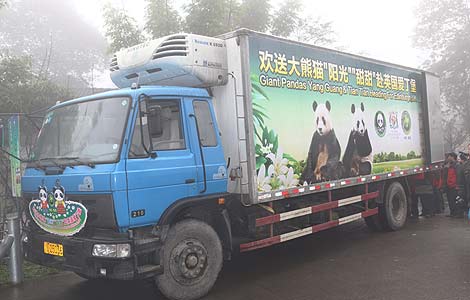Public backs ministry's air quality plans
Updated: 2011-12-08 07:54
By Zheng Xin (China Daily)
|
|||||||||
BEIJING - Feedback on plans to amend China's air quality standard has shown a clear desire among the public for authorities to get stricter, with many calling for pollution checks to factor in PM2.5, officials said on Wednesday.
The Ministry of Environmental Protection began soliciting citizens' comments on Nov 16 and in 21 days received more than 1,500 letters, e-mails and faxes.
According to an official statement, many people said air quality readings should include PM2.5, particulate matter smaller than 2.5 micrometers, which experts say is a major health hazard that can trigger cardiovascular and respiratory diseases, as well as lung cancer.
Suggestions also included key cities like Beijing and Guangzhou implementing the revised standard before Jan 1, 2016, the proposed start date.
Once finalized, the standard will be used to transform the existing Air Pollution Index into the Air Quality Index, which will follow the international practice of including ozone and carbon-monoxide pollution levels.
"Including PM2.5 readings is essential in figuring out the country's haze problems, and it reflects the growing influence of public opinion regarding air quality," said Ma Jun, director of the Public and Environmental Affairs Institute, based in Beijing.
He said his group is among several environmental protection organizations that has been pushing the ministry to introduce the new standard in 12 city clusters, including the Beijing and Tianjin area, the Yangtze River Delta and Pearl River Delta, before 2016.
"It might take some time to promote the new standard nationwide due to different social and economic situations," Ma said. "But since some cities are already capable of releasing PM2.5 readings in terms of technology, we believe the standard can be carried out in key areas as early as next year."
Beijing has 27 monitoring stations capable of reading PM2.5 levels, while Shanghai has more than 20 stations measuring pollutants for scientific research.
The Ministry of Environmental Protection has been under intense pressure in recent weeks as heavy smog shrouded many cities, particularly in North China.
According to air quality readings taken by the US embassy in Beijing, the level of PM2.5 on Sunday night was 522, which is classed as "beyond index".
Emissions from industrial sources contribute most to PM2.5 nationwide, while vehicle emissions are largely to blame most in urban areas, said Ma, adding: "Curbing the burning of leaves and covering construction sites is easy, and would have a great effect on reducing PM2.5."
Dong Liangjie, a former environmental scientist at University of Hawaii, explained that PM2.5 deposits in the lungs can trigger a nervous system imbalance and increase blood pressure within minutes of inhalation.
"People older than 65, children, pregnant women and those suffering asthma and cardiovascular diseases are especially vulnerable," he said.
According to reports, sales of air-purifying products such as humidifiers and face masks have rocketed nationwide due to concern about the thick smog.











